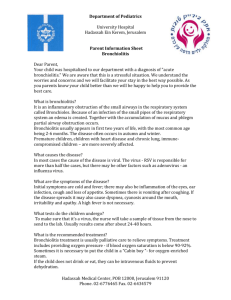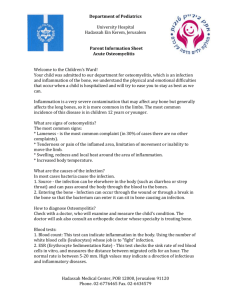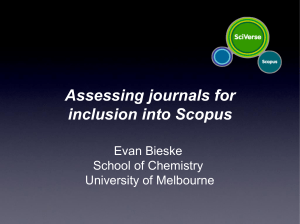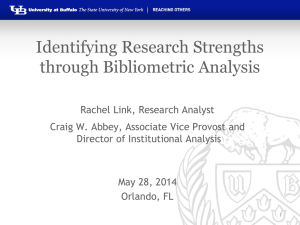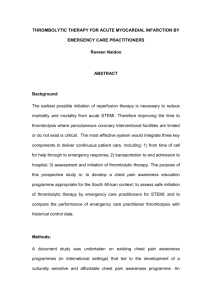Comparison of cardiac units
advertisement
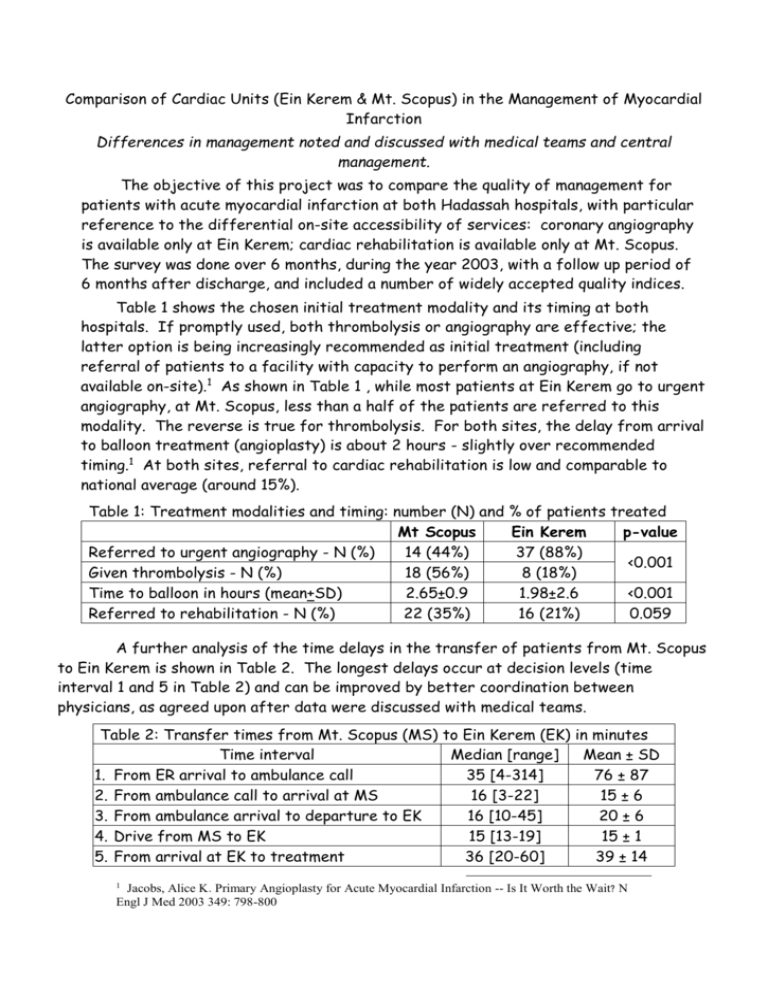
Comparison of Cardiac Units (Ein Kerem & Mt. Scopus) in the Management of Myocardial Infarction Differences in management noted and discussed with medical teams and central management. The objective of this project was to compare the quality of management for patients with acute myocardial infarction at both Hadassah hospitals, with particular reference to the differential on-site accessibility of services: coronary angiography is available only at Ein Kerem; cardiac rehabilitation is available only at Mt. Scopus. The survey was done over 6 months, during the year 2003, with a follow up period of 6 months after discharge, and included a number of widely accepted quality indices. Table 1 shows the chosen initial treatment modality and its timing at both hospitals. If promptly used, both thrombolysis or angiography are effective; the latter option is being increasingly recommended as initial treatment (including referral of patients to a facility with capacity to perform an angiography, if not available on-site).1 As shown in Table 1 , while most patients at Ein Kerem go to urgent angiography, at Mt. Scopus, less than a half of the patients are referred to this modality. The reverse is true for thrombolysis. For both sites, the delay from arrival to balloon treatment (angioplasty) is about 2 hours - slightly over recommended timing.1 At both sites, referral to cardiac rehabilitation is low and comparable to national average (around 15%). Table 1: Treatment modalities and timing: number (N) and Mt Scopus Referred to urgent angiography - N (%) 14 (44%) Given thrombolysis - N (%) 18 (56%) Time to balloon in hours (mean+SD) 2.65±0.9 Referred to rehabilitation - N (%) 22 (35%) % of patients treated Ein Kerem p-value 37 (88%) <0.001 8 (18%) 1.98±2.6 <0.001 16 (21%) 0.059 A further analysis of the time delays in the transfer of patients from Mt. Scopus to Ein Kerem is shown in Table 2. The longest delays occur at decision levels (time interval 1 and 5 in Table 2) and can be improved by better coordination between physicians, as agreed upon after data were discussed with medical teams. Table 2: Transfer times from Mt. Scopus (MS) to Ein Kerem (EK) in minutes Time interval Median [range] Mean ± SD 1. From ER arrival to ambulance call 35 [4-314] 76 ± 87 2. From ambulance call to arrival at MS 16 [3-22] 15 ± 6 3. From ambulance arrival to departure to EK 16 [10-45] 20 ± 6 4. Drive from MS to EK 15 [13-19] 15 ± 1 5. From arrival at EK to treatment 36 [20-60] 39 ± 14 1 Jacobs, Alice K. Primary Angioplasty for Acute Myocardial Infarction -- Is It Worth the Wait? N Engl J Med 2003 349: 798-800 Figure 5 summarizes the overall performance of Hadassah on a number of quality indicators for management of acute myocardial infarction: the percentage of patients receiving aspirin, beta-blockers (BB) and angiotensin converting enzyme inhibitor (ACEI) within 24 h and at discharge, as well as the median timing for thrombolysis or angioplasty (PTCA) in comparison to published USA data for 2001 (JAMA 2003; 289:305). Only a limited portion of the “league” table is reproduced in the figure, with US national average at bottom line “Median”. The conclusion is that the quality performance at Hadassah is generally good in comparison to US practice. Not shown, in-hospital mortality, readmission rate, re-infarction rates and 6 months mortality were also found comparable to reported data elsewhere. Hadassah 89% 90% 50% 83% 69% 44’ 102’ Figure 1: Hadassah performance on quality indicators for the management of acute myocardial infarction, in comparison to national US data All these quality indicators and the need for improvement in some areas (timings, use of beta-blockers, referal to cardiac rehabilitation) were discussed with medical teams and central management. The question of the worth of opening an additional coronary angiography suite at Mt. Scopus was discussed in depth and the option deferred, in part because of the literature data showing excellent results with rapid referral to another site (where angiography is available) and the data presented above showing the feasibility of shortening delays by better coordination between Mt. Scopus and Ein Kerem cardiology teams.
